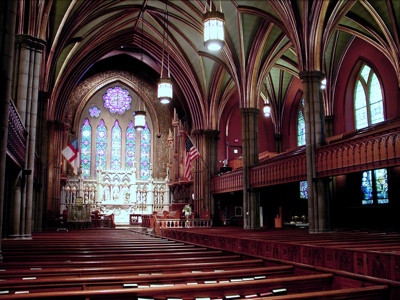
Every morning we drop the kids off at day care and walk about 5 blocks to our offices. In those 10 minutes I walk by Trinity Lutheran Church, Trinity Baptist Church, and St. Mary’s Church (Catholic). Just a block off our route are the three big churches on the New Haven Green: Trinity Church, Center Church, and United Church. All these old churches are pretty much empty during the day and even on Sundays they don’t get nearly the traffic they used to.
Even with all the excitement about the new Pope, the Catholic Church in particular seems to be in decline. While membership has held steady at about 25% of the US population since the 1950’s (largely due to the influx of Latino immigrants), the fraction of members attending mass every Sunday has dropped from 80% to less than 25% over the same period. This has led to huge numbers of parishes closing and lots of hand-wringing on the part of priests and bishops.1
How has this happened? The economist in me says a big part of the answer is competition from newer more exciting denominations and religions. Fundamentalist churches are doing well. The Mormon church is growing like crazy. Around the world Pentecostal and Baha’i faiths are siphoning off members. It also seems that more and more Americans have issues with some of the conservative stances of the Catholic church on birth control, homosexuality, and evolution/creation. Of course, many of the popular new mega-churches are also quite conservative and liberal views haven’t helped the more progressive older denominations.2
The financial cost of losing active members is larger for some denominations3, but I believe the major concern within most denominations is a loss of relevance in the community. I also think most churches don’t want to adapt their principles to gain larger market share. Instead, they’d like new ways to reach out to the community and let them know what churches have to offer. And while I personally am not interested in joining a parish, I do like the idea of other people going somewhere once a week where they are reminded to be nice.
I believe these churches should reach out to their communities by renting out their buildings as office space during the week. They would do it in such a way that it could be converted back and forth in a few hours and so have no effect on weekend services. Imagine office partitions and pews on wheels. If big arenas can have basketball games during the day and hockey at night, this kind of conversion must be easy.
While these churches are beautiful on the outside, the interiors are often breath-taking and always unique. This would induce serious corporate demand. Bigger companies could rent the whole space and break it up into cubicles that could slide in on Monday morning and out on Friday afternoon. Another option would be to turn the sanctuary into an espresso stand and substitute tables and comfy chairs for the pews in the nave. Who wouldn’t rather work there than a cookie-cutter Starbucks or Starbucks-imitator?
This would work out great for the churches too. They would give up almost nothing and get a captive audience for subtle evangelization. The stained glass alone would be a great advertisement for returning on Sunday. The cash infusion to the church would pay for the required capital investment and probably put a fair bit more into the coffers.
In economics there is a concept called a Pareto improvement. This is transaction or change or reallocation of resources that makes at least one person better off without making anyone worse off. It might sound like sacriledge to even talk about turning holy spaces into coffee bars, but it sure seems like a Pareto improvement to me.
-
Msgr. Charles Pope at the the Archdiocese of Washington has a couple terrific blog posts about this subject here and here.↩
-
Unitarian Universalists have been holding steady at around half a million since the 1960’s though there was a bump right after the Unitarians merged with the Universalists. (wiki)↩
-
The Catholic Church can handle declines in contributions better than most since, according to Time Magazine, the Vatican is worth between 10 and 15 billion dollars.↩